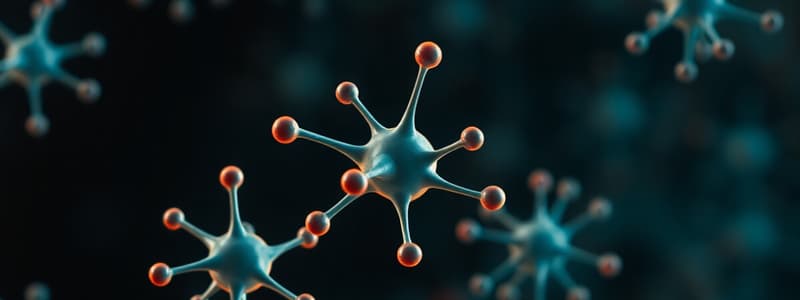Podcast
Questions and Answers
What is a major side effect associated with Haloperidol?
What is a major side effect associated with Haloperidol?
- Elevated prolactin levels (correct)
- Weight gain
- Cognitive enhancement
- Improvement in sleep quality
Which statement correctly describes Haloperidol's potency and risk factors?
Which statement correctly describes Haloperidol's potency and risk factors?
- It has low potency and low risk of extrapyramidal symptoms.
- It has moderate potency and a high risk of sedation.
- It is a low potency medication with minimal side effects.
- It is a high potency antipsychotic with a high risk of extrapyramidal symptoms. (correct)
What is a possible physical effect of elevated prolactin levels due to Haloperidol?
What is a possible physical effect of elevated prolactin levels due to Haloperidol?
- Reduced libido
- Increased appetite
- Menstrual irregularities (correct)
- Excessive sweating
In what category of medications does Haloperidol fall?
In what category of medications does Haloperidol fall?
Which of the following is NOT a typical outcome of using Haloperidol?
Which of the following is NOT a typical outcome of using Haloperidol?
What is a primary function of mood stabilizers like lithium?
What is a primary function of mood stabilizers like lithium?
Which characteristic allows most CNS drugs to access the brain?
Which characteristic allows most CNS drugs to access the brain?
How are most CNS drugs eliminated from the body?
How are most CNS drugs eliminated from the body?
What is a concern when using CNS drugs during early pregnancy?
What is a concern when using CNS drugs during early pregnancy?
Which receptor type is coupled to the Gi protein and inhibits adenylyl cyclase?
Which receptor type is coupled to the Gi protein and inhibits adenylyl cyclase?
What is the effect of the M3 muscarinic acetylcholine receptor activation?
What is the effect of the M3 muscarinic acetylcholine receptor activation?
Which receptor type is not coupled to the Gq protein?
Which receptor type is not coupled to the Gq protein?
What common result occurs from blocking Gq protein-coupled receptors?
What common result occurs from blocking Gq protein-coupled receptors?
What is cyclothymia primarily characterized by?
What is cyclothymia primarily characterized by?
Which disorder is characterized by excessive irritability and anger outbursts in children and adolescents?
Which disorder is characterized by excessive irritability and anger outbursts in children and adolescents?
What is a common side effect of selective serotonin reuptake inhibitors (SSRIs)?
What is a common side effect of selective serotonin reuptake inhibitors (SSRIs)?
Which class of medications is considered the second line for treating depressive disorders after SSRIs?
Which class of medications is considered the second line for treating depressive disorders after SSRIs?
Which disorder must symptoms last for at least two years in adults?
Which disorder must symptoms last for at least two years in adults?
What differentiates monoamine oxidase inhibitors (MAOIs) from selective serotonin reuptake inhibitors (SSRIs)?
What differentiates monoamine oxidase inhibitors (MAOIs) from selective serotonin reuptake inhibitors (SSRIs)?
What is a hallmark symptom of major depressive disorder?
What is a hallmark symptom of major depressive disorder?
Which of the following is a characteristic feature of premenstrual dysphoric disorder (PMDD)?
Which of the following is a characteristic feature of premenstrual dysphoric disorder (PMDD)?
What type of channels are responsible for the propagation of action potentials in nerve cells?
What type of channels are responsible for the propagation of action potentials in nerve cells?
Which mood disorder is characterized by a week-long occurrence of manic symptoms?
Which mood disorder is characterized by a week-long occurrence of manic symptoms?
What distinguishes bipolar II disorder from bipolar I disorder?
What distinguishes bipolar II disorder from bipolar I disorder?
Which pharmacological mechanism involves the binding of neurotransmitters to receptor subunits?
Which pharmacological mechanism involves the binding of neurotransmitters to receptor subunits?
Which of the following is classified as a major depressive disorder?
Which of the following is classified as a major depressive disorder?
What is the primary function of synaptic potentials mediated by ionotropic receptors?
What is the primary function of synaptic potentials mediated by ionotropic receptors?
What characterizes hypomania in bipolar disorder?
What characterizes hypomania in bipolar disorder?
Which neurotransmitter receptor type can modulate voltage-gated ion channels?
Which neurotransmitter receptor type can modulate voltage-gated ion channels?
What side effect of risperidone may explain FS's complaints of agitation and insomnia?
What side effect of risperidone may explain FS's complaints of agitation and insomnia?
What should be evaluated to understand the cause of FS's symptoms related to her current medication?
What should be evaluated to understand the cause of FS's symptoms related to her current medication?
How does risperidone primarily exert its effects compared to other antipsychotics?
How does risperidone primarily exert its effects compared to other antipsychotics?
Which of the following antipsychotics is associated with the highest risk of extrapyramidal symptoms (EPS)?
Which of the following antipsychotics is associated with the highest risk of extrapyramidal symptoms (EPS)?
Which adverse effect is more common with second-generation antipsychotics like risperidone?
Which adverse effect is more common with second-generation antipsychotics like risperidone?
What factor should be considered when assessing FS's medication regime besides her psychiatric condition?
What factor should be considered when assessing FS's medication regime besides her psychiatric condition?
Compared to chlorpromazine, how does the side effect profile of risperidone differ?
Compared to chlorpromazine, how does the side effect profile of risperidone differ?
Which characteristic makes olanzapine distinct among the listed antipsychotics?
Which characteristic makes olanzapine distinct among the listed antipsychotics?
Study Notes
Ion Channels and Neurotransmitter Receptors
- Voltage-gated channels respond to changes in membrane potential.
- Ligand-gated ion channels respond to chemical neurotransmitters.
- Metabotropic receptors bind to G-protein-coupled receptors.
- Neurotransmitter-coupled ion channels are found on cell bodies and on both the presynaptic and postsynaptic sides of synapses.
Mood Disorders
- Mood disorders, also known as affective disorders, are characterized by significant disturbances in emotions.
- Mood disorders are prevalent psychiatric disorders associated with heightened rates of morbidity and mortality.
- Mood disorders are broadly categorized as:
- Bipolar disorders: Bipolar I & Bipolar II disorder, Cyclothymia, Hypomania
- Major Depressive Disorder: Persistent depressive disorder, Disruptive mood dysregulation disorder, Premestrual dysphoric disorder
Bipolar Disorder:
- Bipolar I disorder is characterized by a week-long occurrence of mania symptoms or hospitalization.
- Bipolar II disorder consists of current or past major depressive episodes interspersed with current or past hypomanic periods of at least four days duration.
- Cyclothy mia a milder form of bipolar disorder characterized by periods of low-grade depression and mild hypomania lasting at least 2 years in adults or 1 year in children or adolescents.
- Hypomania less severe form of mania lasting at least four days without significant social or occupational impairment.
Major Depressive Disorder
- Having less interest in normal activities, feeling sad or hopeless, and other symptoms for at least 2 weeks may mean depression
- Persistent depressive disorder is a chronic form of depression that must last at least two years in adults and one year in children and adolescents
Disruptive Mood Dysregulation Disorder (DMDD)
- DMDD is seen in children and adolescents with frequent anger outbursts and irritability out of proportion to the situation.
Premenstrual Dysphoric Disorder (PMDD)
- PMDD is characterized by irritability, anxiety, depression, and emotional lability occurring in a week before the onset of menses followed by resolution of the symptoms after onset
Treatment/Management
- Selective serotonin reuptake inhibitors (SSRIs) are the first-line treatment option for depressive disorder.
- Serotonin-norepinephrine reuptake inhibitors (SNRIs) are the next in line medication for the treatment of depression after SSRIs.
- Monoamine oxidase inhibitors (MAOIs) are marketed as antidepressants.
- Mood stabilizers, like lithium and anticonvulsants, help regulate mood swings in disorders like bipolar disorder.
CNS Drug Characteristics
- Lipid solubility is an important characteristic of most CNS drugs in terms of their ability to cross the blood-brain barrier.
- Access to the CNS of water-soluble (polar) molecules is limited to those of low molecular weight such as lithium ion and ethanol.
Use of CNS Drugs During Pregnancy
- CNS drug use during early pregnancy may increase the risk of a congenital malformation.
- CNS drug use during the later part of pregnancy may be associated with preterm birth, intrauterine growth disturbances and neonatal morbidity.
CNS Drug Elimination
- Excretion is the process by which the drug is eliminated from the body.
- The kidneys most commonly conduct excretion, but for certain drugs, it may be via the lungs, skin, or gastrointestinal tract.
Antipsychotic Drugs
- Antipsychotic drugs to varying degrees act as antagonists at several receptor types, including those for acetylcholine, dopamine, norepinephrine, and serotonin.
- Second-messenger systems for receptor subtypes blocked by antipsychotic drugs:
- D2 (Dopamine D2 receptor): The D2 receptor is coupled to the Gi protein, which inhibits adenylyl cyclase, leading to a decrease in cAMP levels. This also activates potassium channels and inhibits calcium channels.
- M3 (Muscarinic acetylcholine receptor M3): The M3 receptor is coupled to the Gq protein, which activates phospholipase C (PLC). PLC hydrolyzes phosphatidylinositol 4,5-bisphosphate (PIP2) into diacylglycerol (DAG) and inositol triphosphate (IP3). DAG activates protein kinase C (PKC), while IP3 releases calcium from intracellular stores.
- Alpha1 (Alpha-1 adrenergic receptor): The alpha-1 receptor is coupled to the Gq protein, similar to the M3 receptor. This activates PLC, leading to the production of DAG and IP3, which in turn activate PKC and release calcium.
- 5-HT2A (Serotonin 5-HT2A receptor): The 5-HT2A receptor is coupled to the Gq protein, similar to the M3 and alpha-1 receptors. This pathway also activates PLC, leading to the production of DAG and IP3, which activate PKC and release calcium.
Case Study 1 (FS and Risperidone)
- FS, a 35-year-old woman, is receiving risperidone, 3 mg b.i.d., to control a psychotic disorder.
- FS has been taking the drug for 6 months but has recently become agitated and is complaining of insomnia.
- FS’s agitation and insomnia could be related to her risperidone dose.
- Risperidone can cause akathisia, a restless feeling that can manifest as agitation and insomnia.
- This side effect is more common at higher doses.
Further Assessment of FS and Drug Regimen
- A thorough assessment should be made to determine the cause of FS’s symptoms, including:
- Reviewing her medical history and current medications: Are there any other medications that could contribute to her agitation or insomnia?
- Evaluating her mental status: Is there any evidence of worsening psychosis or other psychiatric symptoms?
- Assessing her physical health: Are there any underlying medical conditions that could explain her symptoms?
- Examining her sleep patterns: A sleep diary can help identify potential sleep disturbances.
Comparison of Risperidone with Other Antipsychotics
- Risperidone, chlorpromazine, fluphenazine, olanzapine, and haloperidol are all antipsychotic medications that work by blocking dopamine receptors in the brain.
- They differ in their potency, side effect profiles, and other characteristics:
- Risperidone: A second-generation antipsychotic (SGA) with a relatively low risk of extrapyramidal symptoms (EPS) like tremors and muscle stiffness. It can cause metabolic side effects like weight gain and increased blood sugar.
- Chlorpromazine: A first-generation antipsychotic (FGA) with a high risk of EPS. It is also associated with sedation and anticholinergic effects.
- Fluphenazine: An FGA with a high potency and a higher risk of EPS compared to chlorpromazine.
- Olanzapine: An SGA with a high risk of metabolic side effects. It is generally well-tolerated but can cause sedation and weight gain.
- Haloperidol: An FGA with a high potency and a high risk of EPS. It is also associated with prolactin elevation, which can cause breast enlargement and menstrual irregularities.
Studying That Suits You
Use AI to generate personalized quizzes and flashcards to suit your learning preferences.
Description
This quiz explores the relationship between ion channels, specifically neurotransmitter receptors, and mood disorders. Participants will learn about the types of ion channels and how they contribute to the pathology of mood disorders such as bipolar disorder and major depressive disorder. Test your knowledge on psychiatric disorders and their underlying neurobiology.





